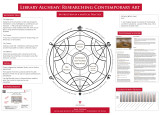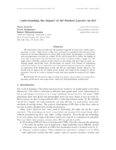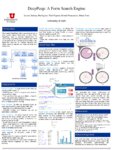Filters: Collection: "ir_uspace"
| Creator | Title | Description | Subject | Date | ||
|---|---|---|---|---|---|---|
| 26 |
 |
Keller, Robert M.; Lindstrom, Gary E. | An architecture for a loosely-coupled parallel processor | An architecture for a large (e. g. 1000 processor) parallel computer is presented. The processors are loosely-coupled, in the sense that communication among them is fully asynchronous, and each processor is generally not unduly delayed by any immediate need for specific data values. The network supp... | Loosely-coupled; Parallel processors | 1978 |
| 27 |
 |
Brunvand, Erik L. | Editorial asynchronous architecture | Asynchronous design is enjoying a worldwide resurgence of interest following several decades in obscurity. Many of the early computers employed asynchronous design techniques, but since the mid 1970s almost all digital design has been based around the use of a central clock. The clock simplifies mos... | 1996-01-01 | |
| 28 |
 |
Davis, Al | Automating the design of embedded domain specific accelerators | Domain specific architecture (DSA) design currently involves a lengthy process that requires significant designer knowledge, experience, and time in arriving at a suitable code generator and architecture for the target application suite. Given the stringent time to market constraints and the dyna... | Domain specific architecture; Stall cycle analysis; SCA; Domain specific accelerators | 2008 |
| 29 |
 |
Tasdizen, Tolga | Using sequential context for image analysis | This paper proposes the sequential context inference (SCI) algorithm for Markov random field (MRF) image analysis. This algorithm is designed primarily for fast inference on an MRF model, but its application requires also a specific modeling architecture. The architecture is composed of a sequence ... | 2010 | |
| 30 |
 |
Carter, John B. | AS-COMA: An adaptive hybrid shared memory Architecture | Scalable shared memory multiprocessors traditionally use either a cache coherent nonuniform memory access (CC-NUMA) or simple cache-only memory architecture (S-COMA) memory architecture. Recently, hybrid architectures that combine aspects of both CC-NUMA and S-COMA have emerged. In this paper, we pr... | AS-COMA; Hybrid shared memory | 1998 |
| 31 |
 |
Fujimoto, Richard M. | On synthesizing systolic arrays from recurrence equations with linear dependencies | We present a technique for synthesizing systolic architectures from Recurrence Equations. A class of such equations (Recurrence Equations with Linear Dependencies) is defined and and the problem of mapping such equations onto a two dimensional architecture is studied. We show that such a mapping is ... | Recurrence equations | 1986 |
| 32 |
 |
Kumar, Sidharth; Pascucci, Valerio | Remote visualization | Generalized Architecture and pipeline for a remote site | ||
| 33 |
 |
Brunvand, Erik L. | Precise exception handling for a self-timed processor | Self-timed systems structured as multiple concurrent processes and communicating through self-timed queues are a convenient way to implement decoupled computer architectures. Machines of this type can exploit instruction level parallelism in a natural way, and can be easily modified and extended... | 1995 | |
| 34 |
 |
Leither, Luke | Library alchemy: researching contemporary art | This poster was created to present a workshop for researching contemporary art in the Marriott Library. The workshop and poster was created by Luke Leither, the Art and Architecture Library at the University of Utah. | Art; Contemporary Art; Research; Fine Arts | 2013 |
| 35 |
 |
Frey, Lewis J. | Enhancing caBIG™ workflow for multi-tier distribution | Introduction caBIG™ Integration caBIG™ provides a GRID based application environment with data abstraction and vocabulary services, workflow management and a security framework. Sensor Abstraction Interface It is proposed to provide a sensor abstraction interface, using caDSR, enabling caBIG... | caBIG; Sensor abstraction interface; Multi-tier distribution; Trapeze Interactive Poster | 2009 |
| 36 |
 |
Cotter, Neil E. | Generality Vs. speed of convergence in the cart-pole balancer | This paper compares the speed of convergence to an optimal solution of four controllers for the problem of balancing a pole on a cart. We demonstrate that controllers whose design is tailored specifically to the cart-pole problem (i.e. less general) converge more rapidly to an optimal solution. How... | Cart-pole balancer; Generality; Speed of convergence | 1991 |
| 37 |
 |
Lindstrom, Gary E. | ETYMA: a framework for modular systems | Modularity, i.e. support for the flexible construction, adaptation, and combination of units of software, is an important goal in many systems. In most cases, however, systems achieve only a few aspects of modularity. The problem can be traced to the inflexibility, or the limited view of modularity ... | ETYMA; Modularity; Modular systems | 1994 |
| 38 |
 |
Balasubramonian, Rajeev | Microarchitectural wire management for performance and power in partitioned architectures | Future high-performance billion-transistor processors are likely to employ partitioned architectures to achieve high clock speeds, high parallelism, low design complexity, and low power. In such architectures, inter-partition communication over global wires has a significant impact on overall proc... | Microarchitecture; Partitioned architectures; Heterogeneous interconnects; Cache access | 2005 |
| 39 |
 |
Stevens, Kenneth | A single chip low power asynchronous implementation of an FFT algorithm for space applications | A fully asynchronous _x000C_fixed point FFT processor is introduced for low power space applications. The architecture is based on an algorithm developed by Suter and Stevens specifi_x000C_cally for a low power implementation. The novelty of this architecture lies in its high localization of compo... | 1998 | |
| 40 |
 |
Balasubramonian, Rajeev | Understanding the impact of 3D stacked layouts on ILP | 3D die-stacked chips can alleviate the penalties imposed by long wires within micro-processor circuits. Many recent studies have attempted to partition each microprocessor structure across three dimensions to reduce their access times. In this paper, we implement each microprocessor structure on a s... | 2007-01-01 | |
| 41 |
 |
Carter, Tony M. | Cascade: hardware for high/variable precision arithmetic | The Cascade hardware architecture for high/variable precision arithmetic is described. It uses a radix-16 redundant signed-digit number representation and directly supports single or multiple precision addition, subtraction, multiplication, division, extraction of the square root and computation... | 1989 | |
| 42 |
 |
Carter, John B. | Avalanche: A communication and memory architecture for scalable parallel computing | As the gap between processor and memory speeds widens, system designers will inevitably incorporate increasingly deep memory hierarchies to maintain the balance between processor and memory system performance. At the same time, most communication subsystems are permitted access only to main memory ... | Avalanche; Computer memory; Memory architecture | 1995 |
| 43 |
 |
Drews, Frank; Bermudez, Julio Cesar; Agutter, James A.; Foresti, Stefano A.; Westenskow, Dwayne R.; Syroid, Noah Daniel; Tashjian, Elizabeth | Between art, science and technology: data representation architecture | As our civilization continues to dive deeper into the information age, making sense of complex data becomes critical. This work takes on this challenge by means of a novel method based on complete interdisciplinarity, design process and built-in evaluations. The result is the design, construction, ... | Data representation; Visualization design; Data environments | 2005 |
| 44 |
 |
Elens, Robert N. | Sequencing computational events in heterogeneous distributed systems | Distributed systems are growing in number, size, and complexity. Some technological advances have been made to program these systems, most notably the remote procedure call. However, the nature of heterogeneous distributed systems allows for much more complex interactions and new programming techno... | Sequencing; Computational events; Heterogeneous distributed systems | 1990 |
| 45 |
 |
Brunvand, Erik L. | Estimating performance of an ray- tracing ASIC design | Recursive ray tracing is a powerful rendering technique used to compute realistic images by simulating the global light transport in a scene. Algorithmic improvements and FPGA-based hardware implementations of ray tracing have demonstrated realtime performance but hardware that achieves performance ... | 2006 | |
| 46 |
 |
Brunvand, Erik L. | The NSR processor | The NSR (Non-Synchronous RISC) processor is a general-purpose computer structured (IS U collection of self-timed blocks that operate concurrently and communicate over bundled data channels in the style of micropipelines [3, 16]. These blocks correspond to standard synchronous pipeline stages such ... | 1993 | |
| 47 |
 |
Hibler, Michael J. | The flask security architecture: system support for diverse security policies | Operating systems must be flexible in their support for security policies, i.e., the operating system must provide sufficient mechanisms for supporting the wide variety of real-world security policies. Systems claiming to provide this support have failed to do so in two ways: they either fail to pro... | Flask; Security architecture | 1998 |
| 48 |
 |
Carter, John B. | Analysis of avalanche's shared memory architecture | In this paper, we describe the design of the Avalanche multiprocessor's shared memory subsystem, evaluate its performance, and discuss problems associated with using commodity workstations and network interconnects as the building blocks of a scalable shared memory multiprocessor. Compared to other ... | Avalanche multiprocessor; Shared memory | 1997 |
| 49 |
 |
Pascucci, Valerio | Hybrid Computing for HPC Applications | 2012 | ||
| 50 |
 |
Nguyen, Hoa Thanh; Nguyen, Thanh Hoang; Freire, Juliana | DeepPeep: A Form Search Engine | We present DeepPeep (http://www.deeppeep.org), a new search engine specialized in Web forms. DeepPeep uses a scalable infrastructure for discovering, organizing and analyzing Web forms which serve as entry points to hidden-Web sites. DeepPeep provides an intuitive interface that allows users t... |
